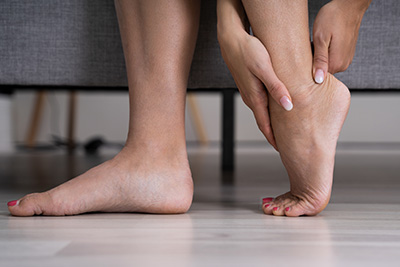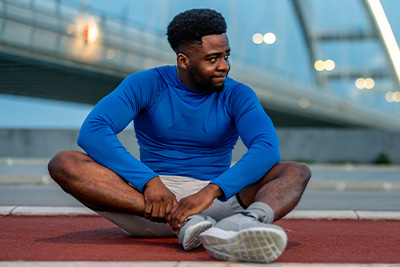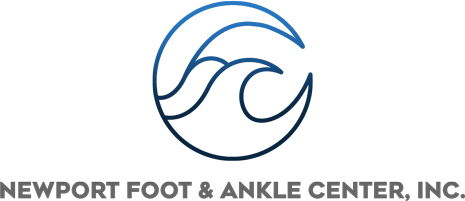Achilles tendinitis is a condition characterized by inflammation of the Achilles tendon, the thick band of tissue that connects the calf muscles to the heel bone. It commonly occurs due to repetitive stress or overuse, particularly in activities involving running, jumping, or sudden changes in intensity. The condition manifests with symptoms such as pain, stiffness, and swelling in the back of the ankle or heel. Without proper treatment, it can progress to more severe forms, impacting mobility and requiring longer recovery periods.
Achilles Tendinitis
Anaheim and Newport Beach
Achilles tendinitis is a common overuse injury involving inflammation of the Achilles tendon, the large band of tissue connecting the calf muscles to the heel bone. It often results from repetitive stress or a sudden increase in the intensity of physical activity. Dr. Haupt at Newport Foot & Ankle Center offers personalized, conservative treatments for Achilles tendinitis in Anaheim and Newport Beach.
What is Achilles tendinitis?

Signs & symptoms:
- Pain and tenderness along the Achilles tendon, particularly near the heel
- Stiffness and limited range of motion in the ankle, especially after periods of inactivity
- Swelling or thickening of the tendon, often accompanied by warmth to the touch
- Mild to severe discomfort, which may ease with rest but worsen with continued stress
- Noticeable crepitus or crackling sensation in the tendon during movement
- Possible development of nodules or lumps along the tendon, indicating chronic inflammation
- Gradual onset of symptoms that may worsen over time without proper treatment
Contact us for a personalized care plan for your Achilles tendinitis in Anaheim and Newport Beach.
Possible causes:
- Overuse or repetitive strain on the Achilles tendon due to activities such as running, jumping, or sudden changes in physical intensity
- Inadequate warm-up or improper stretching before engaging in physical exercise
- Tight calf muscles or Achilles tendon, predisposing individuals to microtears and inflammation
- Poor footwear choices or worn-out shoes lacking proper support, resulting in increased strain on the tendon
- Biomechanical issues, such as flat feet, high arches, or abnormal foot pronation, altering the distribution of forces along the lower extremities
- Sudden increase in intensity or duration of physical activity, exceeding the tendon’s capacity to adapt and leading to overuse injuries
- Age-related degeneration of the tendon’s structure, making it more susceptible to injury

Diagnosis
Diagnosing Achilles tendinitis typically begins with a thorough medical history and physical examination by a healthcare professional, such as Dr. Haupt. During the examination, Dr. Haupt will assess the affected area for tenderness, swelling, and range of motion. He may perform specific tests, such as the Thompson test, where gentle squeezing of the calf muscle evaluates the integrity of the Achilles tendon.
In some cases with Achilles tendinitis in Anaheim and Newport Beach, Dr. Haupt may recommend imaging studies like ultrasound or MRI to confirm the diagnosis and assess the extent of tendon damage. These imaging modalities provide detailed images of the tendon, helping Dr. Haupt rule out other potential causes of symptoms, such as tendon tears or inflammation of surrounding structures. With a comprehensive evaluation, Dr. Haupt can develop an appropriate treatment plan tailored to your individual needs
Treatment options
Treatment for Achilles tendinitis typically involves rest, stretching, and strengthening exercises. However, Dr. Haupt will curate a personalized treatment plan based on your condition.
Rest and activity modification
Dr. Haupt will likely recommend temporarily avoiding activities that aggravate your symptoms to allow the Achilles tendon to heal. This may involve reducing or modifying your exercise routine, avoiding high-impact activities like running or jumping, and incorporating rest periods into your daily schedule. Once symptoms improve, a gradual reintroduction of activity will be advised.
Physical therapy and stretching
A physical therapist can design a tailored rehabilitation program to strengthen the muscles surrounding the Achilles tendon and improve flexibility. This may include eccentric exercises to gradually load the tendon, calf stretches, and proprioceptive training to enhance balance. Regular participation in these exercises can reduce the risk of future Achilles tendinitis in Anaheim and Newport Beach.
Other treatment modalities
In addition to rest and physical therapy, Dr. Haupt may recommend other treatment modalities to alleviate pain and promote healing. These may include:
- Orthotic Devices: Custom orthotic inserts or supportive footwear can help correct biomechanical issues contributing to Achilles tendinitis.
- Nonsteroidal Anti-Inflammatory Drugs (NSAIDs): Over-the-counter medications like ibuprofen or naproxen can help reduce pain and inflammation.
- Corticosteroid Injections: In some cases, Dr. Haupt may administer corticosteroid injections to alleviate severe pain and inflammation.
Schedule your consultation
Newport Foot & Ankle Center is your premier destination for comprehensive care and expertise in treating Achilles tendinitis in Anaheim and Newport Beach. Under the guidance of Dr. Jeffrey Haupt, a fellowship-trained podiatric specialist, you can expect personalized attention and effective treatment options tailored to your needs. Don’t let Achilles tendinitis hinder your mobility and quality of life — schedule your consultation today.


